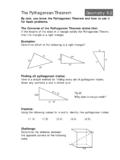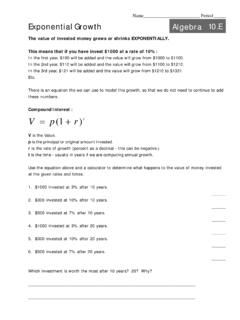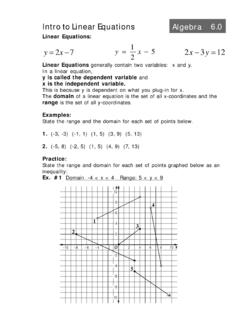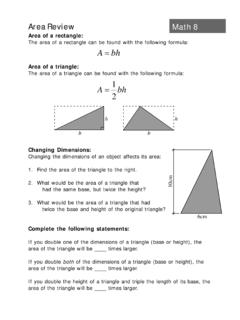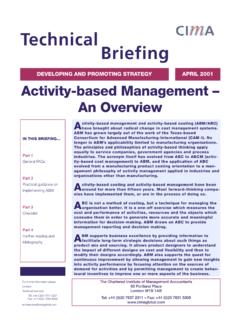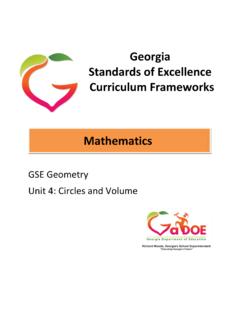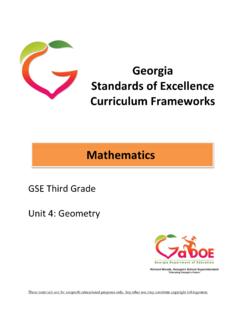Transcription of Inductive Reasoning Geometry 2 - AGMath.com
1 Inductive Reasoning Geometry Inductive Reasoning : Observing Patterns to make generalizations is induction. Example: Every crow I have seen is black, therefore I generalize that all crows are black'. Inferences made by Inductive Reasoning are not necessarily true, but are supported by evidence. Think: How could you use Inductive Reasoning to find Pi (the ratio of a circle's circum- ference to its diameter)? Practice: Use Inductive Reasoning to determine the next two numbers in each sequence: 1. 1, 1, 2, 3, 5, 8, 13, ___, ___, .. 2. 5, 4, 6, 3, 7, 2, ___, ___, .. 1 1 3 2 1. , , , , , _ , _ ,.. 3. 10 5 10 5 2. 4. 1, 2, 2, 4, 8, ___, ___, .. 5. 2, 3, 5, 7, 11, ___, ___, .. 6. 1, 2, 6, 15, 31, 56, ___, ___, .. Induction is very important in Geometry . Often, a pattern in Geometry is rec- ognized before it is fully understood. Today we will use Inductive Reasoning to discover the sum of the measures of interior angles in a pentagon.
2 With a partner: Use a straight-edge to draw an irregular convex pentagon. Trade with a part- ner, and measure each of the five interior angles in the pentagon. Add these angles and share the data with your partner. We will compare data from other groups in the class to see if we can come up with a generalization. (If you already know the sum, humor me. It is still a good exercise to demon- strate Inductive Reasoning ). Now, look for a pattern that will help you discover the sum of the interior angles in figures with more than five sides. Sum of interior angles in a figure given the number of sides: 3 = 180o 4=360o 5 = 540o 6 = ___o 7 = ___o Inductive Reasoning Geometry Rulers for making circle measurements to find Pi. 0 1 2 3 4 5 6 7. 0 1 2 3 4 5 6 7. 0 1 2 3 4 5 6 7. 0 1 2 3 4 5 6 7. 0 1 2 3 4 5 6 7. 0 1 2 3 4 5 6 7. 0 1 2 3 4 5 6 7. 0 1 2 3 4 5 6 7. 0 1 2 3 4 5 6 7.
3 Deductive Reasoning Geometry Deductive Reasoning is the process of using accepted facts and logic to arrive at a valid conclusion. Example: All mammals have fur (or hair). Lions are classified as mammals. Therefore, Lions have fur. Bad example: All mammals have fur or hair. Caterpillars have hair. Caterpillars are mammals. In Geometry : In the diagram below, what is the relationship between segments AC and BD? Explain why this is true using Algebra. A B C D. Applying Deductive Reasoning : We used Inductive Reasoning to show that the sum of the interior angles in a pentagon appears to always equal to 540o. Use the following accepted information to show why this is always true. Given: The sum of all interior angles in a triangle is always 180o. Try to create another diagram with explanation which shows why the five angles in a star will always add up to 180o. (We are getting way ahead of ourselves with this one.)
4 Functions Geometry Finding the nth term: For many patterns and sequences, it is easy to find the next term. Finding the 105th term may be much more difficult. Most patterns can be defined by an equation. Examples: Write a function equation based on the following data: term 1 2 3 4 5. value -3 0 3 6 9. n 4 7 10 13 16. f(n) -2 4 10 16 22. Patterns in Geometry can be described similary: Try to write an equation which describes this pattern to determine how many toothpicks' it takes to create each figure in the pattern. It may help to create a table of values. Some patterns are non-linear equations, but are still simple to write an equation for how many non-overlapping squares there will be in the nth figure. You will need to recognize ways of counting and patterns to help you define more difficult patterns. In the figures above, how many straight toothpicks'.
5 Are in each figure? Write an equation that could help you discover how many lines would be needed to draw the 18th figure. Quiz Review Geometry Find the next two terms: 100.. 3, 8, 15, 24, 35, ___, ___, .. 200.. 5, 11, 16, 27, 43, 70, ___, ___ , .. 300.. 3 2 5 3 7 4 9. , , , , , , , ___, ___, .. 5 3 7 4 9 5 11. 400.. 360, 180, 120, 90, ___, ___, .. Inductive or Deductive? 100. Concluding that the sum of the angles in a regular hexagon is 720o using the known formula 180(n-2). 100. Sketching numerous quadrilaterals to show that it is impossible for a quadrilateral to have exactly three right angles. 100. Demonstrating that the difference of consecutive perfect squares will always be an odd number: (n 1) 2 (n) 2 . (n 2 2n 1) n 2 . 2n 1 (an even number +1 is odd). Use Inductive Reasoning to support each statement as true or false. If false, provide a counterexample.
6 100. The number of diagonals in a regular polygon will always be greater than the number of sides. 200. A concave polygon must have at least four interior angles measuring less than 180o. 300. If you multiply consecutive prime numbers, double the result, and add one, the result will always be prime. How many toothpicks' will be needed to make the nth figure? 300. Name_____ Period _____. Practice Quiz Geometry Find the next two terms in each sequence. Show your Reasoning below each problem. All of these are standard mathematical sequences (not ). 1.. 5, 7, 12, 19, 31, 50, ___, ___, .. 1. _____ _____. 2.. 4, 10, 18, 28, 40, 54, 70, ___, ___, .. 2. _____ _____. 3.. 7, 11, 13, 17, 19, 23, 29, ___, ___, .. 3. _____ _____. 4.. 80, 40, 120, 60, 180, 90, ___, ___, .. 4. _____ _____. 1 7 2 3 5. 5.. , , , , , ___, ___, .. 2 12 3 4 6. 5. _____ _____. Determine whether each conjecture was made by Inductive or deductive Reasoning : 6.
7 Gordon conjectured that adding any two odd numbers will always equal an even number by adding 3+5=8, 5+7=12, 17+9=26, all the way to numbers like 191+273=464. 6. Circle: Inductive or deductive? 7. Vickie conjectured that the sum of all four angles in a square will always add up to 360o, because all four angles are right angles therefore 4 times 90o = 360o. 7. Circle: Inductive or deductive? 8. Evan conjectured that angles 1 and 2 below will always be equal because 1+ 3 = 2+ 3 (180o) because they create a straight line, therefore subtracting 3 leaves 1 = 2. 1. 3 8. Circle: Inductive or deductive? 2. 9. Amika conjectured that there are an infinite number of primes. If you take all the known prime numbers, multiply them together, and add one, then the number will either be prime, or it will have a factor greater than the largest known prime.. 9. Circle: Inductive or deductive?
8 Name_____ Period _____. Practice Quiz Geometry Use Inductive Reasoning to determine if you believe each statement is true or false. If you discover a statement that is false, provide a counterexample. 10. Multiplying two perfect squares will always yield another perfect square. 10. T/F ____ _____. 11. If x is odd, then x2 must also be odd. 11. T/F ____ _____. 12. The sum of two integers will always be greater than either of the two integers. 12. T/F ____ _____. 13. The square root of any real number will always be less than the number itself. 13. T/F ____ _____. 14. It is possible to express any positive even number greater than two as the sum of two prime numbers. 14. T/F ____ _____. Write a function equation to find the nth term in each sequence: 15. n 1 2 3 4 5. f(n) -9 -7 -5 -3 -1. 15. _____. 16. How many toothpicks' will there be in the nth figure? 16.
9 _____. 17. How many toothpicks' (not triangles) will there be in the nth figure? You have seen similar patterns before. 17. _____. Pledge: The Bowling Pin' Pattern Geometry Intro to geometric sequences: n=1 n=2 n=3 n=4. f(n)=1 1+2 1+2+3 1+2+3+ n( n 1). f (n) . 2. Today we will look at this function in a particularly useful way: To find the number of pins in the nth figure, it is useful to look at the bowling pin pattern with numbers: The nth figure will have 1 + 2 + 3 + 4 + 5 + .. + n pins. There are n rows of pins. How could you find the average number of pins in each row? To find the average number of pins in each row: Add the first row (1) to the last row (n) and divide by 2. Therefore, the number of pins is just the number of rows (n) times the average number of pins in each row (n+1)/2. THIS ONLY WORKS IF THE PATTERN OF NUMBERS ADDED IS. STRICTLY ARITHMETIC (5+7+9+11, but not 8+12+20+36+.)
10 Lets see how this can help write a different formula for the pattern below: n=1 n=2 n=3. f(n)=3 3+4 3+4+5 3+4+5+..+(n+2). The Bowling Pin' Pattern Geometry You should memorize the standard bowling pin function. n( n 1). f (n) . 2. Instead of using the average method, it is also possible to simply MODIFY THE BOWLING PIN PATTERN. Example: How many toothpicks will there be in the nth figure? n=1 n=2 n=3. You should recognize this as the bowling pin pattern, only doubled. 2n( n 1). Therefore: f ( n) n(n 1). 2. It is also possible (though often confusing) to look at a pattern that is simple a shift of the standard pattern: n=1 n=2 n=3. You should recognize that the pins in the first figure are the same as the pins in the 3rd figure of the standard bowling pin pattern. The pattern is simply shifted up' by 2. Modify the standard formula, replacing n with n+2: n( n 1) ( n 2)(n 3).


